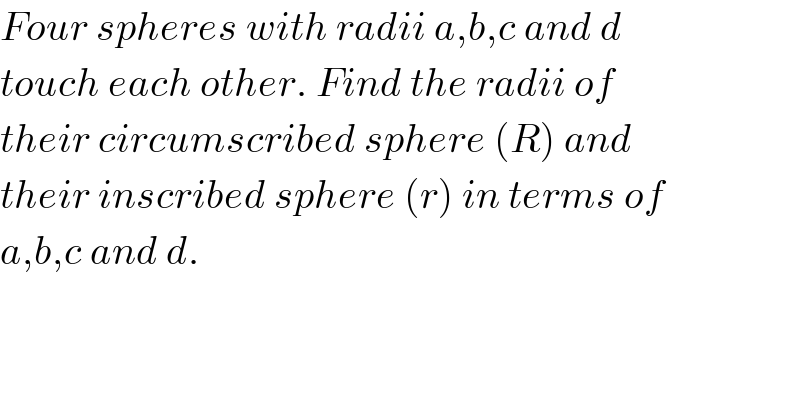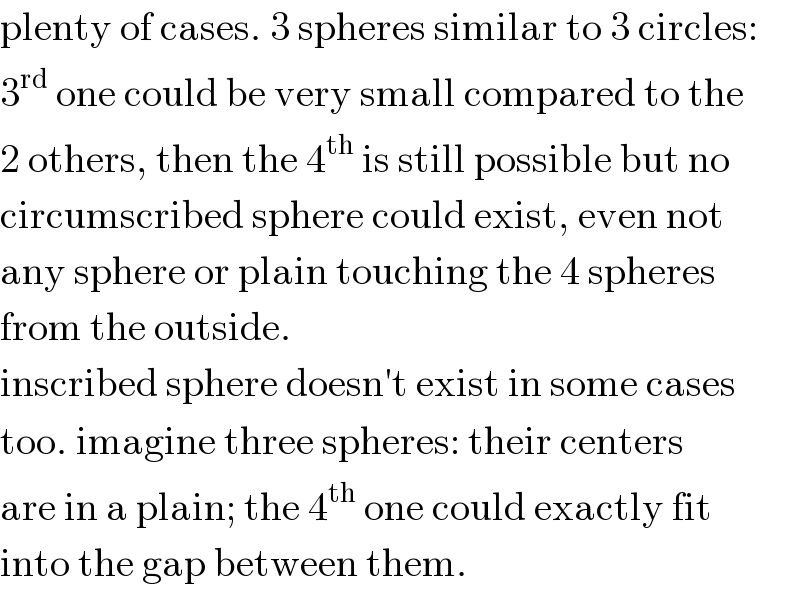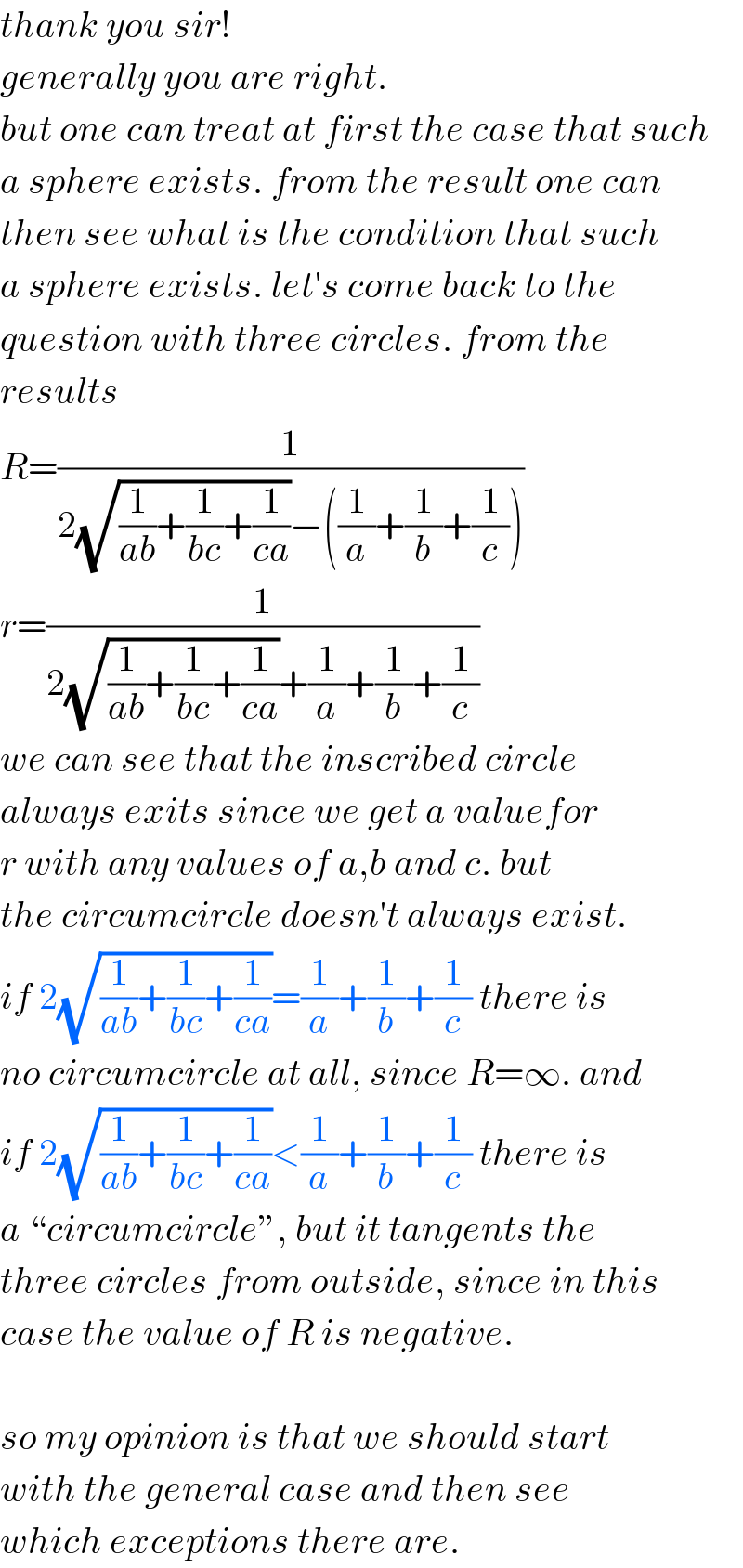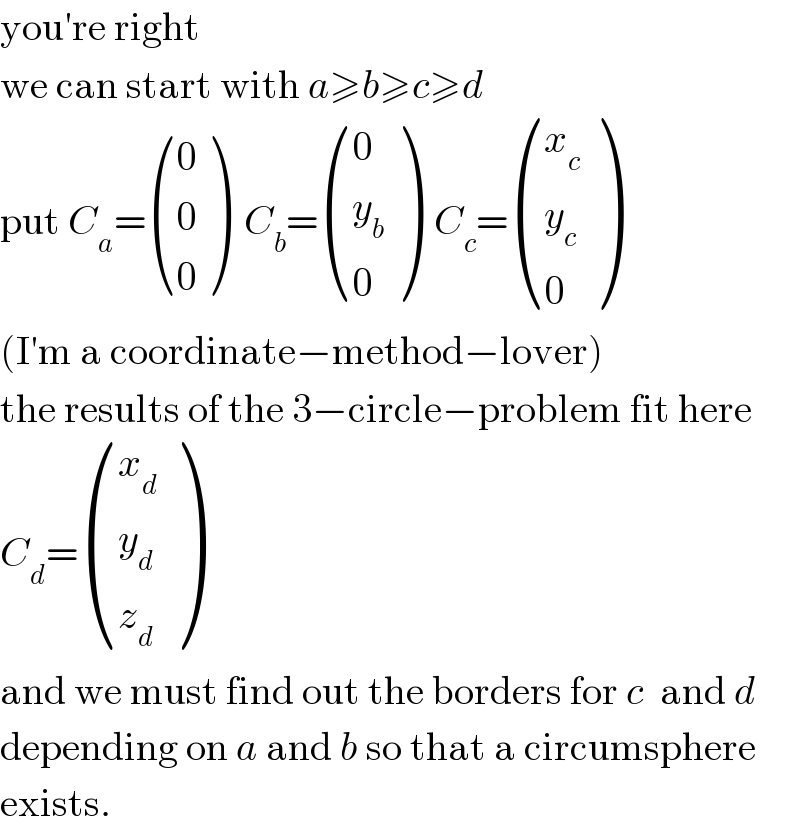
Question Number 46481 by MrW3 last updated on 27/Oct/18

$${Four}\:{spheres}\:{with}\:{radii}\:{a},{b},{c}\:{and}\:{d} \\ $$$${touch}\:{each}\:{other}.\:{Find}\:{the}\:{radii}\:{of} \\ $$$${their}\:{circumscribed}\:{sphere}\:\left({R}\right)\:{and} \\ $$$${their}\:{inscribed}\:{sphere}\:\left({r}\right)\:{in}\:{terms}\:{of}\: \\ $$$${a},{b},{c}\:{and}\:{d}. \\ $$
Commented by MJS last updated on 27/Oct/18

$$\mathrm{plenty}\:\mathrm{of}\:\mathrm{cases}.\:\mathrm{3}\:\mathrm{spheres}\:\mathrm{similar}\:\mathrm{to}\:\mathrm{3}\:\mathrm{circles}: \\ $$$$\mathrm{3}^{\mathrm{rd}} \:\mathrm{one}\:\mathrm{could}\:\mathrm{be}\:\mathrm{very}\:\mathrm{small}\:\mathrm{compared}\:\mathrm{to}\:\mathrm{the} \\ $$$$\mathrm{2}\:\mathrm{others},\:\mathrm{then}\:\mathrm{the}\:\mathrm{4}^{\mathrm{th}} \:\mathrm{is}\:\mathrm{still}\:\mathrm{possible}\:\mathrm{but}\:\mathrm{no} \\ $$$$\mathrm{circumscribed}\:\mathrm{sphere}\:\mathrm{could}\:\mathrm{exist},\:\mathrm{even}\:\mathrm{not} \\ $$$$\mathrm{any}\:\mathrm{sphere}\:\mathrm{or}\:\mathrm{plain}\:\mathrm{touching}\:\mathrm{the}\:\mathrm{4}\:\mathrm{spheres} \\ $$$$\mathrm{from}\:\mathrm{the}\:\mathrm{outside}. \\ $$$$\mathrm{inscribed}\:\mathrm{sphere}\:\mathrm{doesn}'\mathrm{t}\:\mathrm{exist}\:\mathrm{in}\:\mathrm{some}\:\mathrm{cases} \\ $$$$\mathrm{too}.\:\mathrm{imagine}\:\mathrm{three}\:\mathrm{spheres}:\:\mathrm{their}\:\mathrm{centers} \\ $$$$\mathrm{are}\:\mathrm{in}\:\mathrm{a}\:\mathrm{plain};\:\mathrm{the}\:\mathrm{4}^{\mathrm{th}} \:\mathrm{one}\:\mathrm{could}\:\mathrm{exactly}\:\mathrm{fit} \\ $$$$\mathrm{into}\:\mathrm{the}\:\mathrm{gap}\:\mathrm{between}\:\mathrm{them}. \\ $$
Commented by MrW3 last updated on 27/Oct/18

$${thank}\:{you}\:{sir}! \\ $$$${generally}\:{you}\:{are}\:{right}. \\ $$$${but}\:{one}\:{can}\:{treat}\:{at}\:{first}\:{the}\:{case}\:{that}\:{such} \\ $$$${a}\:{sphere}\:{exists}.\:{from}\:{the}\:{result}\:{one}\:{can} \\ $$$${then}\:{see}\:{what}\:{is}\:{the}\:{condition}\:{that}\:{such} \\ $$$${a}\:{sphere}\:{exists}.\:{let}'{s}\:{come}\:{back}\:{to}\:{the} \\ $$$${question}\:{with}\:{three}\:{circles}.\:{from}\:{the} \\ $$$${results} \\ $$$${R}=\frac{\mathrm{1}}{\mathrm{2}\sqrt{\frac{\mathrm{1}}{{ab}}+\frac{\mathrm{1}}{{bc}}+\frac{\mathrm{1}}{{ca}}}−\left(\frac{\mathrm{1}}{{a}}+\frac{\mathrm{1}}{{b}}+\frac{\mathrm{1}}{{c}}\right)} \\ $$$${r}=\frac{\mathrm{1}}{\mathrm{2}\sqrt{\frac{\mathrm{1}}{{ab}}+\frac{\mathrm{1}}{{bc}}+\frac{\mathrm{1}}{{ca}}}+\frac{\mathrm{1}}{{a}}+\frac{\mathrm{1}}{{b}}+\frac{\mathrm{1}}{{c}}} \\ $$$${we}\:{can}\:{see}\:{that}\:{the}\:{inscribed}\:{circle} \\ $$$${always}\:{exits}\:{since}\:{we}\:{get}\:{a}\:{valuefor} \\ $$$${r}\:{with}\:{any}\:{values}\:{of}\:{a},{b}\:{and}\:{c}.\:{but} \\ $$$${the}\:{circumcircle}\:{doesn}'{t}\:{always}\:{exist}. \\ $$$${if}\:\mathrm{2}\sqrt{\frac{\mathrm{1}}{{ab}}+\frac{\mathrm{1}}{{bc}}+\frac{\mathrm{1}}{{ca}}}=\frac{\mathrm{1}}{{a}}+\frac{\mathrm{1}}{{b}}+\frac{\mathrm{1}}{{c}}\:{there}\:{is} \\ $$$${no}\:{circumcircle}\:{at}\:{all},\:{since}\:{R}=\infty.\:{and} \\ $$$${if}\:\mathrm{2}\sqrt{\frac{\mathrm{1}}{{ab}}+\frac{\mathrm{1}}{{bc}}+\frac{\mathrm{1}}{{ca}}}<\frac{\mathrm{1}}{{a}}+\frac{\mathrm{1}}{{b}}+\frac{\mathrm{1}}{{c}}\:{there}\:{is} \\ $$$${a}\:``{circumcircle}'',\:{but}\:{it}\:{tangents}\:{the} \\ $$$${three}\:{circles}\:{from}\:{outside},\:{since}\:{in}\:{this} \\ $$$${case}\:{the}\:{value}\:{of}\:{R}\:{is}\:{negative}. \\ $$$$ \\ $$$${so}\:{my}\:{opinion}\:{is}\:{that}\:{we}\:{should}\:{start} \\ $$$${with}\:{the}\:{general}\:{case}\:{and}\:{then}\:{see} \\ $$$${which}\:{exceptions}\:{there}\:{are}. \\ $$
Commented by MJS last updated on 27/Oct/18

$$\mathrm{you}'\mathrm{re}\:\mathrm{right} \\ $$$$\mathrm{we}\:\mathrm{can}\:\mathrm{start}\:\mathrm{with}\:{a}\geqslant{b}\geqslant{c}\geqslant{d} \\ $$$$\mathrm{put}\:{C}_{{a}} =\begin{pmatrix}{\mathrm{0}}\\{\mathrm{0}}\\{\mathrm{0}}\end{pmatrix}\:\:{C}_{{b}} =\begin{pmatrix}{\mathrm{0}}\\{{y}_{{b}} }\\{\mathrm{0}}\end{pmatrix}\:\:{C}_{{c}} =\begin{pmatrix}{{x}_{{c}} }\\{{y}_{{c}} }\\{\mathrm{0}}\end{pmatrix} \\ $$$$\left(\mathrm{I}'\mathrm{m}\:\mathrm{a}\:\mathrm{coordinate}−\mathrm{method}−\mathrm{lover}\right) \\ $$$$\mathrm{the}\:\mathrm{results}\:\mathrm{of}\:\mathrm{the}\:\mathrm{3}−\mathrm{circle}−\mathrm{problem}\:\mathrm{fit}\:\mathrm{here} \\ $$$${C}_{{d}} =\begin{pmatrix}{{x}_{{d}} }\\{{y}_{{d}} }\\{{z}_{{d}} }\end{pmatrix} \\ $$$$\mathrm{and}\:\mathrm{we}\:\mathrm{must}\:\mathrm{find}\:\mathrm{out}\:\mathrm{the}\:\mathrm{borders}\:\mathrm{for}\:{c}\:\:\mathrm{and}\:{d} \\ $$$$\mathrm{depending}\:\mathrm{on}\:{a}\:\mathrm{and}\:{b}\:\mathrm{so}\:\mathrm{that}\:\mathrm{a}\:\mathrm{circumsphere} \\ $$$$\mathrm{exists}. \\ $$
